A platform to connect
freelance journalists
and media houses
Project overview
101 Reporters is a network of freelance journalists and acts as a bridge between freelancers and media houses. They accept story ideas from reporters, fine-tune them and pitch them to media houses.
My role
UX UI Designer | Maxc studio
User research, Information architecture, wireframing, visual design & usability testing.
Duration
Mar-Dec 2019,
(9 months)
Client

Intro
Project overview
101Reporters is a platform for freelance journalists who can and are open to write articles and blogs on their own wish 101 reporters website needed to be redesigned to make it help its users in such a way that freelancers will be able to showcase articles on the website. At the same time, these articles need to be categorised into news categories to make it easy for media houses to pick and buy articles from journalists where 101 reporters will act as mediators between media houses and journalists. The soul purpose of this project is to build a platform which which connects freelance journalists and media houses.
Business goals
- To let the freelancers know 101 reporters is the fastest growing platform for freelance journalists by converting visitors into freelance journalists by signing up with 101 reporters.
- Building a strong brand identity makes it easy for freelancers to identify and to make a recognizable brand among media houses
Design process
We have done our research and decided to follow the Design Thinking approach of problem-solving, which is a nonlinear approach, to achieve good outcomes from the product we are building.
Design Thinking is a design methodology that provides a solution-based approach to solving problems. It’s extremely useful in tackling complex problems that are ill-defined or unknown, by understanding the human needs involved, by re-framing the problem in human-centric ways, by creating many ideas in brainstorming sessions, and by adopting a hands-on approach in prototyping and testing. Understanding these five stages of Design Thinking will empower anyone to apply the Design Thinking methods in order to solve complex problems that occur around us – in our companies, in our countries, and even on the scale of our planet.
Empathise
User Research
Secondary research
A 5-day workshop was conducted with the stakeholders of 101 reporters and freelance journalists. My research encompassed –
My limited experience with freelancing meant that I needed to gain an understanding of freelancers and their pain points in the world of journalism. To begin building this foundational knowledge, we undertook extensive secondary user research, conducting:
- Online ethnography, forum analysis: Understand user habits, the tools they use, and their challenges.
- Analyzing freelancer demographics: Clearly define the target audience, and understand how freelancers work.
- Analyzing freelancer interviews and daily routine accounts: Identify non-billable tasks they complete regularly.
This approach allowed us to gain a high-level understanding of freelance needs, the features they seek out, and how they approach media houses.
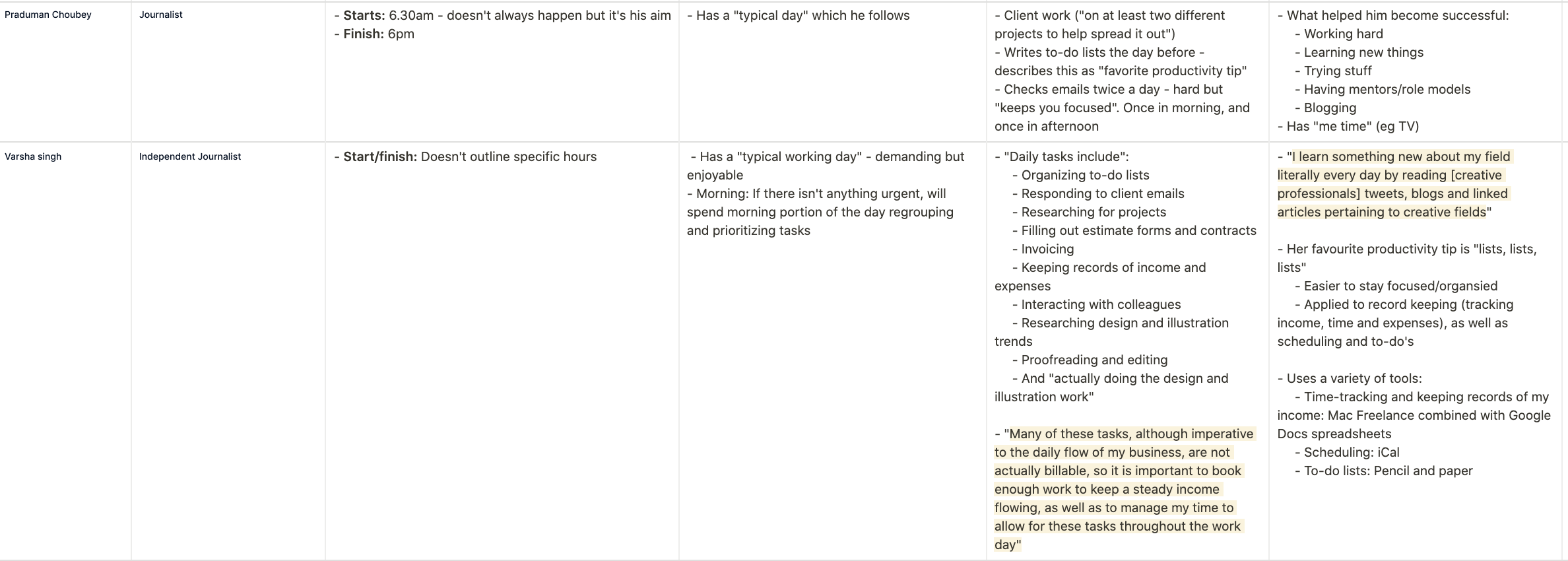
A snippet of secondary user research
Primary research
Primary research gave us a valuable starting point, however I wanted to conduct primary user research to really delve into the daily work life of a freelancer.
For a deeper understanding of freelance needs and challenges, we recruited and conducted a user interview in order to learn about freelance attitudes towards, and management of, non-billable tasks. Because this interview presented a small, non-representative sample, I also conducted a user survey to collect additional data.
The goal of my research was to better understand the experience and feelings of freelancers when completing non-billable tasks. Key insights from my discovery research include:
- Key tasks: To-do lists, emailing, logging time spent, finance tracking
- Key pain points: Lack of holistic experience/single system, outdated UI, not visual enough
- Key freelancer behavior: Use multiple apps, lack of work routine, many work part-time, spend 1-2 hours on non-billable tasks per day
What do stake holders have to say?

"I quit mainstream media to pursue my interest in highlighting local stories that don't find space in national media. Only two percent of India's mainstream media coverage is about rural issues. Even though almost 70 percent of India's population, 1.3 billion population, live in villages. This is disturbing for a democratic country like India, where transparency is key to ensuring justice to everyone, especially the poor. So, I was convinced that there's a need to build a platform to bring out this important story at the national level."
-Gangadhar Patil, Founder and CEO at 101 Reporters
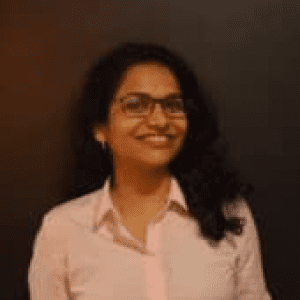
"I have been working closely with journalists. I have seen most of them struggling to deliver or work in a specific deadlines. Which is really hard for a true journalist. Journalist always wanted to say the truth to our world which sometimes goes beyond the deadlines. Beside this most Freelance or independent journalists struggle to get a good pay for their hard work and dedication which is really a heart breaking moment."
- Milli Mishra, Director at 101 Reporters

"I am not a journalist but have been working on tech in media industry and understanding the major tech problems facing by users of media and journalists. I have seen more people being passionate to be a journalist. When people spend a good amount of time other than their primary work and if the time they are spending goes in vain because media houses could refuse to publish their story or they may not get a good reward for their hard work demotivates people and puts them away from their passionate work. So we have decided to build a platform and help independent journalists to pitch their articles with a good reward and at the same help media houses to pick a small but powerful stories."
- Amol Dhekane, Co-Founder and CTO at 101 Reporters
Potential users
From the research, business goals and stakeholder interviews we are able to identify the users and have divided them into three categories namely primary users, secondary users and terfiary users. Users who fall into the primary sector are the one’s who will be highly beneficial cause we are trying to solve the problems of freelance journalists with 101 reporters as a platform. The secondary sector is taken by the media houses which play a major role in buying the stories written by freelancers. There is another category of people who can be turned into potential primary users when they sign up with the platform who cannot be ignored.

What do individual user groups think?
On interviewing and talking to the users of 101 reporters, which includes freelance journalists and media houses, we tried to include questions that are related to the media industry to get to know about the field in a better way. This research mainly focuses on learning about people’s opinions and their assumptions on where the news industry is leading and how the changes are affecting their lives as full-time people on the field. Based on this research we have developed a data chart on what individual categories think they are facing the biggest problems in journalism
today.

What individual categories think they are facing the biggest
problems in journalism today and how have different groups reacted.
Define
Analysing data
Empathy map
We have gone through a lot of research where we have learnt different things from regular news readers, freelancers, media houses and stakeholders of the company. Also, we have seen some surprising elements and facts in the field of media and journalism.
We started analyzing all the data, qualitative and quantitative, which we have gathered from both primary and secondary research. By analyzing this data we have moved on to the next step in the design process which is to define our users, identify their pain points and develop a problem statement.

User persona
The insights we have uncovered from both my primary and secondary research allowed us to create a user persona. These user personas represent the core users for the client’s business. From the instructions and requests from the client, we are clear that we are solving the problems of the freelance journalists as the highest priority rather than focusing on the pain points of media houses. So we have come up with two personas having different stories.


Synthesizing data
Problem statement

Hypothesis statement

Ideate
Brainstorming
Coming up with as many ideas as possible plays a crucial role for a solution that can fulfil the user needs. We can have choose rapid ideation technique. Our goal is to come up with as many solutions as possible that ideally solves the users keen problem. With the help of the user research we have done, along the personas we have took into consideration has played a major role in this.
Creating a better Journey for freelancers acted as a major challenge for the team. Developing and testing a seamless user experience during this journey has been taken into priority. At this point in time, we were very clear that users are facing a lot of issues with the journey that they are being into. We decided to build a better path for freelance journalists rather than just building a platform to showcase their stories so media houses can show their interest.

Snap of post-it's on the wall during brainstorming session.
Information architecture
Coming up with as many ideas as possible plays a crucial role for a solution that can fulfil the user needs. We can have choose rapid ideation technique. Our goal is to come up with as many solutions as possible that ideally solves the users keen problem. With the help of the user research we have done, along the personas we have took into consideration has played a major role in this.

User flow
The insights we have uncovered from both my primary and secondary research allowed us to create a user persona. These user personas represent the core users for the client’s business. From the instructions and requests from the client, we are clear that we are solving the problems of the freelance journalists as the highest priority rather than focusing on the pain points of media houses. So we have come up with two personas having different stories.
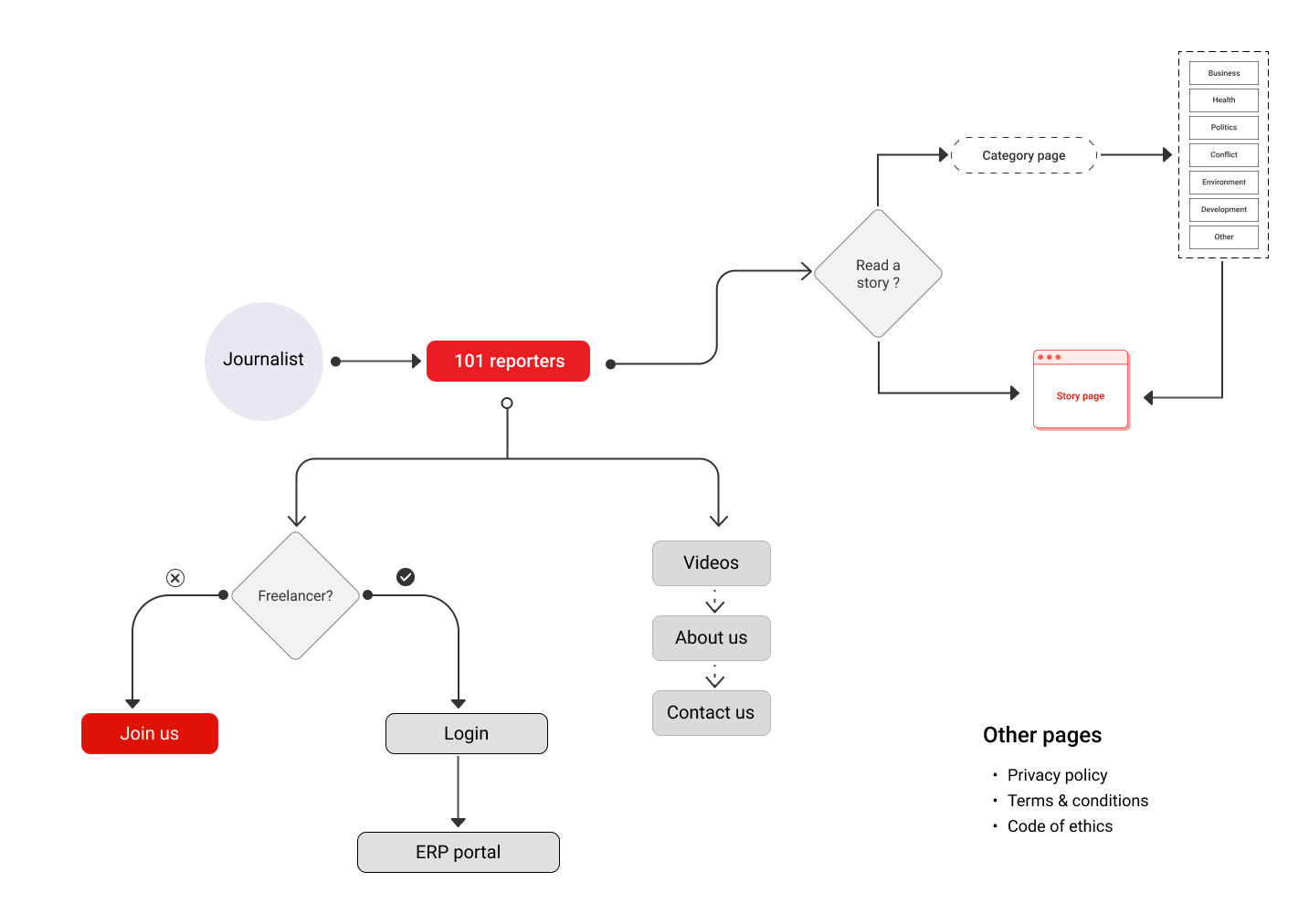
A non-freelance journalist user flow map to increase sign up rate.
Wireframing
Low-Fidelity wireframes
With the bunch of ideas we explored as a team has come up different wireframes representing the ideas we have come up in the brain storming session. We have tested as many ideas as possible and collected every possible feedback. Below are few of the ideas we have worked on.
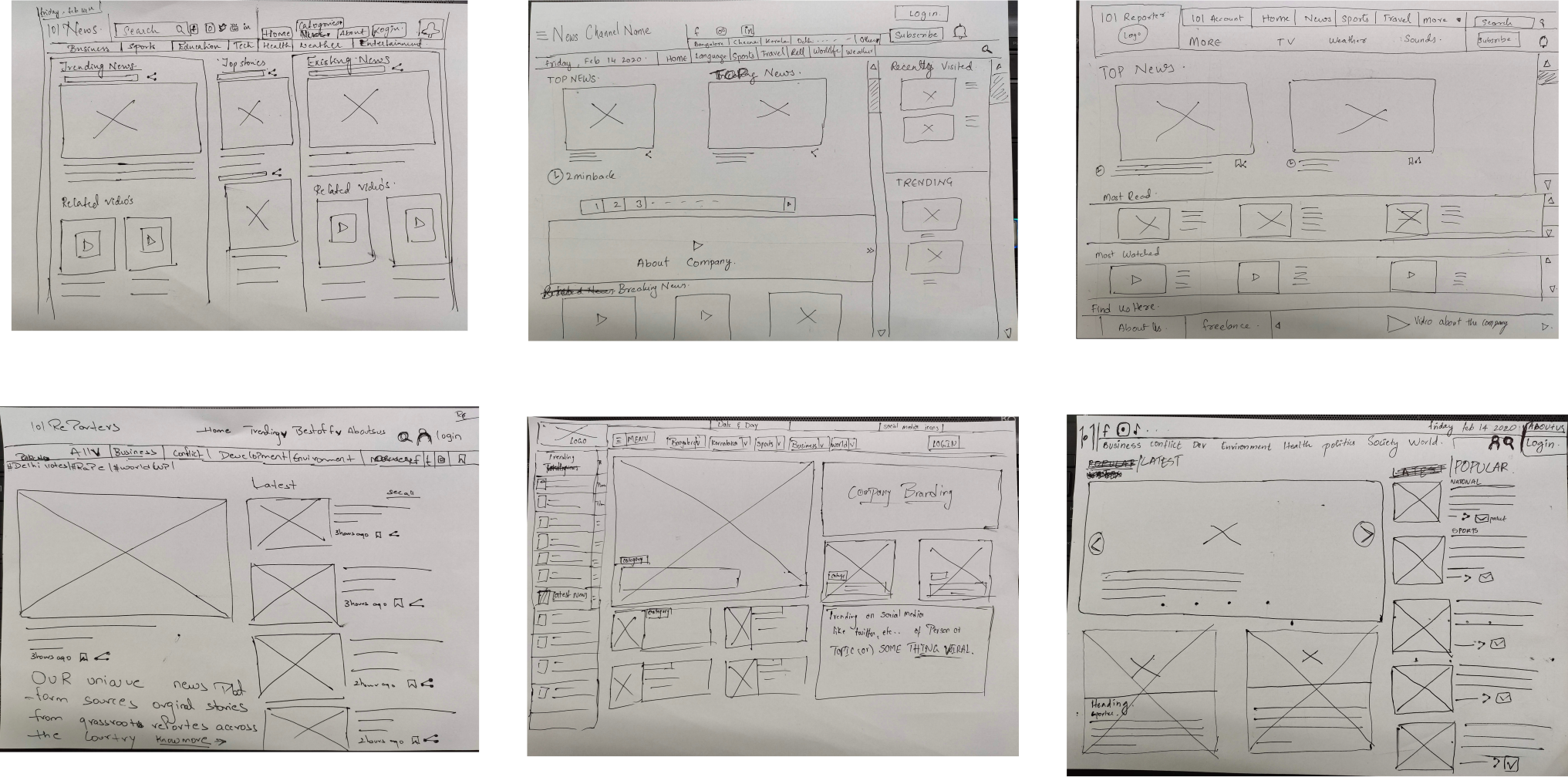
Prototype & Testing
High-Fidelity wireframes
Secondary research gave us a valuable starting point, however I wanted to conduct primary user research to really delve into the daily work life of a freelancer.
For a deeper understanding of freelance needs and challenges, we recruited and conducted a user interview in order to learn about freelance attitudes towards, and management of, non-billable tasks. Because this interview presented a small, non-representative sample, I also conducted a user survey to collect additional data.
The goal of my research was to better understand the experience and feelings of freelancers when completing non-billable tasks. Key insights from my discovery research include:

Visual design
This was extremely challenging as we had to design a complete library of individual design components for implementing the vision of unified design. Fonts, color palettes, story cards, widgets, and UI elements, each of them have a separate library and do’s and don’ts to provide users with a stunning experience.

UI design
We ideated in collaboration on what the new Information architecture of the platform should look like, ensuring that it is usable and scalable.
For proper hands-on collaboration and to provide real-time visibility of progress to the stakeholders we chose Figma as our design tool. All stakeholders were invited to that space, and feedback were taken from them. Figma was a lifesaver in this project as it enabled us to design things that were technologically feasible – since time was a constraint.
Complete usability testing was done at every stage. We employed the focus groups technique and user observation at each stage.
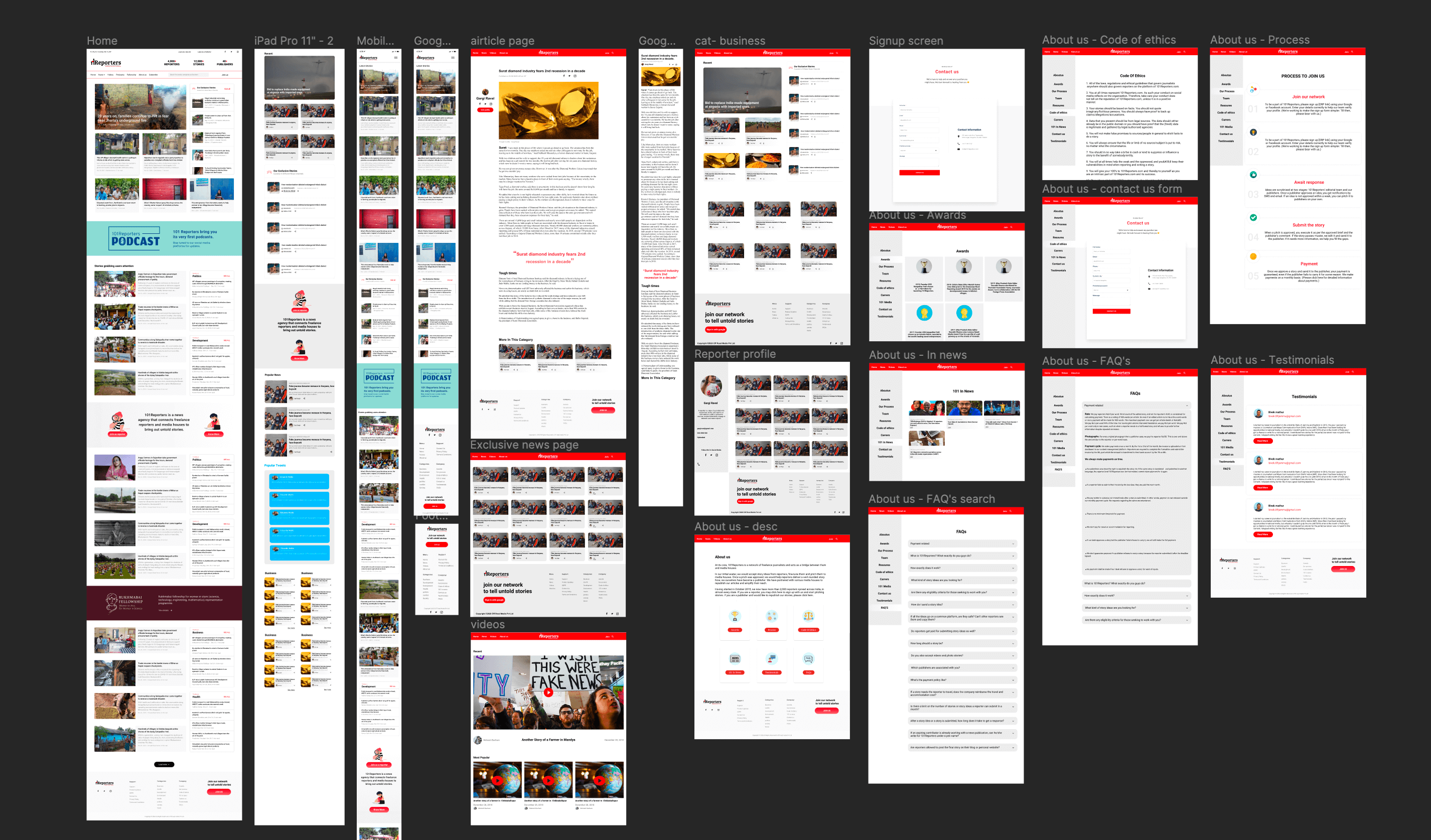
Prototyping
We have developed prototypes during every phase of our design process and iterated designs with the new learning we have come across when we have tested it out with users. We were glad that we were able to interact with the real users who were on the client’s database.
We took feedback from both primary and secondary users along with feedback from the client. We were able to test with different users who have different goals to achieve with the product we are designing for.
Work time gallery





